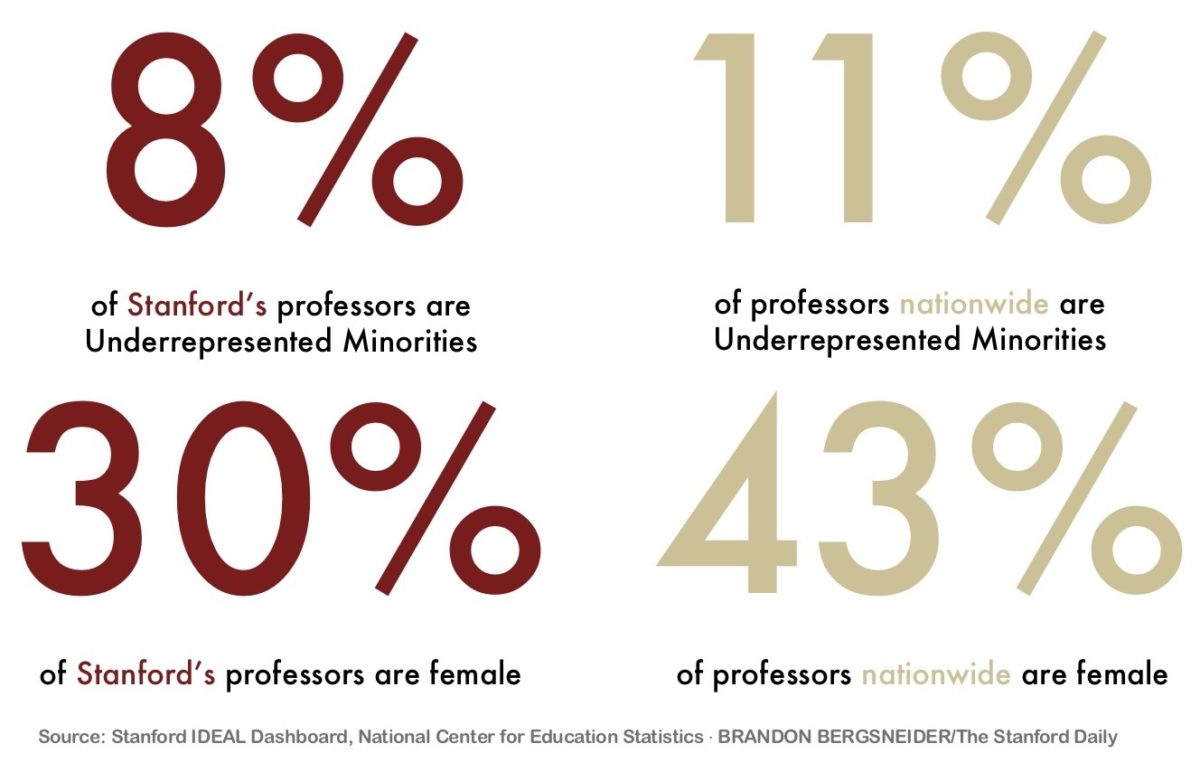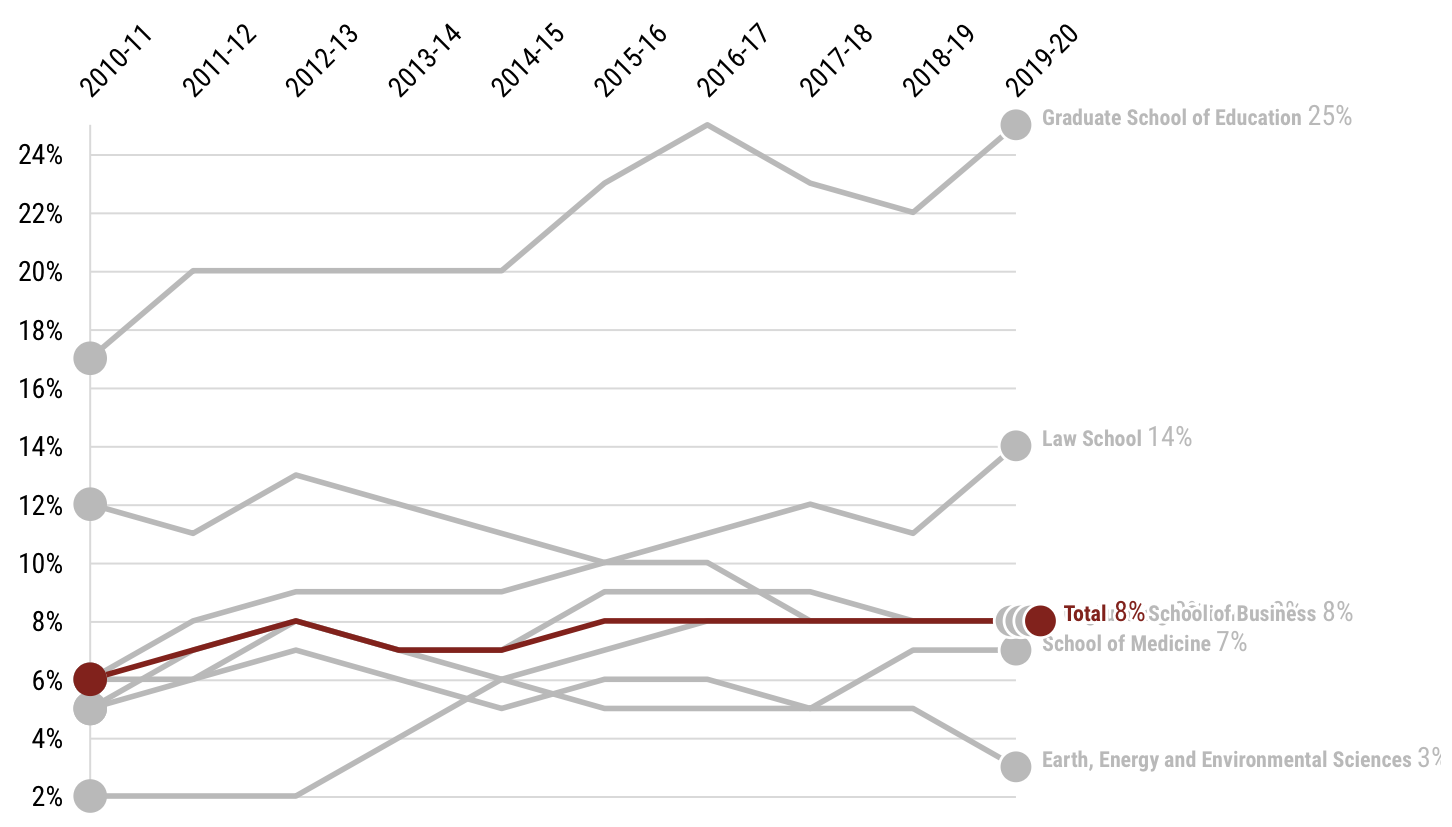Data for this story can be found at the Stanford Open Data Portal.
As communities across the country reel from the murders of George Floyd, Ahmaud Arbery, Breonna Taylor and countless other black lives lost to police and state violence, we must reconsider the structures of racism that devalue black and other POC voices. One of these structures is undoubtedly the lack of faculty diversity on college campuses which motivates the following questions:
Why are professors much less diverse than the students they teach? How can we learn about diverse cultures and histories when very few professors actually come from such backgrounds? How can universities make systemic change to improve professor diversity?
These are questions students across the country have been seeking answers to since before the student civil rights movements of the 1960s, and within the last few years, student demands for faculty diversity have grown louder and louder.
Last year, 13 professors at Yale, mostly people of color, threatened to resign from the school’s ethnic studies program because of lack of institutional support from the school’s administrators, including limitations on hiring new faculty. In December, after a Black Latina professor at Harvard was denied tenure, students occupied an administration building in protest. And in February, students at the University of Oklahoma staged a sit-in at the provost’s office to advocate for more diversity initiatives after two professors used the N-word during class lectures (one of whom compared using the phrase “OK Boomer” to using the N-word).
Here at Stanford, the student activist group Who’s Teaching Us? has stood in solidarity with protesters at other colleges and is leading initiatives that implore Stanford to offer more ethnic studies, increase faculty diversity and decrease the prevalence of hate crimes on campus. These demands have become even more poignant in the last few weeks following outrage after two Stanford faculty, an assistant professor in art history and a law professor, read the N-word aloud in class.
To understand these demands, and how effective Stanford has been at addressing them, let’s take a deeper look at Stanford’s faculty diversity over the past 10 years and how it compares to faculty diversity at other universities across the nation.
According to data from Stanford’s Inclusion, Diversity, Equity, and Access in a Learning Environment (IDEAL) Dashboard, only 8% of Stanford’s professors identify as underrepresented minorities (URMs), and only 30% of professors are female. This is in stark contrast with the undergraduate student body, of which 34% of students are URMs and 50% are female.
URM representation among professors has increased only 2 percentage points (pp.) over the last 10 years, from 6% in 2010-11 to 8% in 2019-20.
Notably, there are currently zero Native Hawaiian/Pacific Islander professors, only one more black professor than in 2010, and only two more American Indian/Alaskan Native professors than in 2010. The number of Hispanic professors has increased by 37 in the past 10 years, and the number of multiracial professors has increased by 26.
Looking at individual schools, the School of Earth, Energy and Environmental Science had the lowest proportion of URM professors (3%) and was tied for the smallest improvement in minority representation (increase of 1 pp. since 2010). The school currently has three Hispanic professors but no other reported URM professors. The School of Medicine also only had a 1 pp. increase in the last 10 years (from 6% to 7%). On the other hand, the Graduate School of Education had both the highest proportion of URM professors (25%) and the greatest improvement in the last 10 years (8 pp. increase).
Looking at sex, the percentage of female professors has only increased by 4 percentage points over the past 10 years, and it is interesting that 63% of Stanford’s entire staff is female, but only 30% of its professors are female. The data suggest that although Stanford can tout gender balance across its staff, equal opportunity across genders is not a reality for esteemed professoriate positions.
At 19%, the School of Engineering and the Graduate School of Business both have the lowest proportion of female professors. At 39%, the Graduate School of Education has the highest proportion of female professors. However, this number actually decreased from 45% in 2010. And over the past 10 years, the School of Earth, Energy and Environmental Science showed the greatest increase in female representation (from 22% in 2010 to 36% now).
Although Stanford is home to institutions that are world-leaders in gender equality research, such as The Clayman Institute for Gender Research, the school itself still has a long way to go.
How does Stanford’s professor diversity compare to schools across the US?
Compared to nationwide data from the National Center for Education Statistics, Stanford has both less URM representation and less female representation among professors than the nationwide average.

And even compared to the University of California system, which Stanford often competes with for professor recruitment, Stanford has less URM and female professors and has performed worse at improving professor diversity over the past 10 years.
Across its ten universities, the UC System has increased the proportion of URM professors from 8% in 2010 to 11% in 2019, while Stanford has remained at 8%. The UC System has also increased the proportion of female professors from 29% in 2010 to 34% in 2019. Stanford is still only at 30% female professors. Of course, both Stanford and the UC system have work to do to improve professor diversity, but Stanford is uniquely lagging behind both UC system and nationwide averages.
Part of what may explain the UC System’s success is its systemwide efforts to promote diversity. Such efforts include strengthening the academic pipeline to bring more of the UC’s diverse graduate students into the faculty ranks, conducting detailed reviews of the faculty recruitment process, and providing support networks for minority faculty. Stanford also has several initiatives, such as designated funds to recruit and retain diverse faculty, but this data analysis suggests such initiatives have been less effective.
This article started by asking why professors are much less diverse than the students they teach, how students can learn about diverse cultures and histories when very few professors actually come from such backgrounds and what steps Stanford can take to improve professor diversity. Although this article does not have any answers to those questions, Stanford doesn’t either. Stanford has not only made minimal improvements in professor diversity over the past 10 years, but it also lags behind colleges across the nation. As teachers, students, and organizations such as Who’s Teaching Us? make louder and louder calls for professor diversity, Stanford’s administration will need to do a better job at answering these questions.
The data used for this report was from the Stanford IDEAL Dashboard, the National Center for Education Statistics and the UC System Infocenter. All data was manually curated in Excel, and visualizations were made using Flourish and Powerpoint.
This article has been updated to include references to the data stored on the Stanford Open Data Portal.
Contact Brandon Bergsneider at bbergs ‘at’ stanford.edu.
